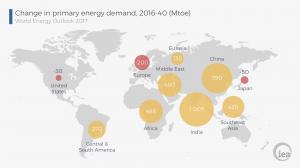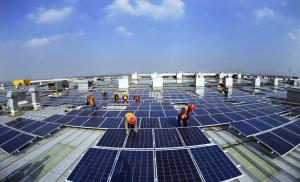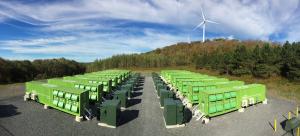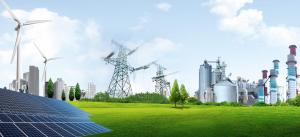In 2024, the scale of new energy projects started globally reached a new record high, with a total of 28 million kilowatts started for the year.
DUBAI, UAE, April 12, 2024 /EINPresswire.com/ — In 2024, the global new energy construction project will scale to a new high, and the annual total construction will reach 28 million kilowatts. Among them, the photovoltaic power generation project gradually rose to 7.13 million kilowatts, the energy storage project 1.91 million kilowatts, the wind power project continues to account for the big head of 13.55 million kilowatts, new energy vehicle power exchange project 11 million kilowatts.
New energy this industry vocabulary for most people is not strange, nowadays, the rapid development of the global society, coupled with people’s demand for increasing living standards, can use the resources in the already limited circumstances to continue to be developed.
When the idea of new energy was officially defined by the United Nations in 1981, it gradually came into people’s view, and countless new energy industry chains and companies developing new energy sources sprang up within a few years. With the limited availability of conventional energy sources and the growing prominence of environmental issues, new energy sources that are environmentally friendly and renewable are gaining more and more attention from various countries.
Taking photovoltaic as an example, China, the United States, and Europe are the three regions with the largest installed capacity of new photovoltaic, accounting for 43%, 28%, and 18% of the global total respectively. This is a substantial proportion of data for many countries, however, this data, with the 2024 new energy another round of heatwave impact, will only increase.
Source:https://www.solarpowereurope.org/insights/outlooks/global-market-outlook-for-solar-power-2023-2027/detail
And the big head of new energy – wind energy, the Global Wind Energy Council (GWEC) expects, in the 2023 ~ 2027 period, wind power will enter a new round of rapid development, and new wind power installed capacity is expected to reach 680GW, that is, an average of 136GW per year, the total amount of installed capacity.
The new energy tide is coming, as an important part of the power transmission materials, the cable industry will also usher in a new round of growth. However, both opportunities and challenges exist, accompanied by fierce competition and escalating market demand.
Source:https://gwec.net/global-wind-workforce-outlook-2023-2027-pr/
Renewable Energy Integration
One of the most prominent ways the cable industry influences the energy sector is through integrating renewable energy sources into the power grid. As the world increasingly turns to solar, wind, and other forms of renewable energy to reduce carbon emissions and combat climate change, the demand for efficient transmission infrastructure has never been higher.
Cable companies are playing a crucial role in this transition by developing advanced transmission technologies capable of efficiently transporting electricity from remote renewable energy sites to urban centers and industrial hubs. High-voltage direct current (HVDC) transmission systems, for example, are becoming increasingly common, enabling the long-distance transmission of renewable energy with minimal losses.
Moreover, advancements in cable manufacturing techniques are allowing for the production of cables capable of handling higher voltages and currents, further enhancing the efficiency and reliability of renewable energy transmission networks. This has paved the way for the development of large-scale offshore wind farms and solar parks, which can now deliver clean energy to distant shores with unprecedented efficiency.
Photovoltaic Industry
The rapid development of the photovoltaic industry makes the demand for photovoltaic cables is also expanding, photovoltaic cables are used to transport current or signal wire and cable products, mainly used for power supply systems in the negative grounding devices in the DC circuit. Its voltage level is usually 0.6/1kV or 0.4/0.6kV, there are some up to 35kV.
An industry source said: “With the arrival of the parity era, the photovoltaic industry is about to enter an explosive growth stage. In the next 5-8 years, PV will become one of the world’s leading sources of electricity.” Henan ZMS cable staff said: “According to the factory’s annual exports of fiber optic cables, photovoltaic cables in photovoltaic power plants accounted for about 10% of the value of the volume, there is a significant increase, but its value of the volume accounted for 30% -40% so that photovoltaic cables as a photovoltaic industry chain has very broad prospects for development. ” ZMS cable, relying on more than thirty years of cable R & D and production experience, in materials, processes, performance, service, and other aspects of high-quality development as a starting point, continues to provide the market with good cable.
Energy storage Industry
The “sudden rise” of the energy storage industry should not be underestimated. The rapid development of the energy storage industry, its rapid development is inseparable from the “double carbon” goal to promote lithium battery technology progress. Mainly used to connect the charging and discharging equipment of the energy storage power station, control equipment, high-voltage DC cables, and low and medium-voltage AC cables used to connect the transformers, distribution cabinets, and lighting, control and other low-voltage equipment in the energy storage power station, the demand will also increase significantly.
Although “the scenery is unique”, the rapid development of new energy also puts forward higher requirements for the cable industry.
On the one hand, in the new energy development, the performance of traditional cable products has made it difficult to meet the needs of the new energy sector. Such as the photovoltaic field, due to the impact of ground construction, cable trench will be limited, and space constraints; and direct sunlight will affect the surface temperature of the cable, which affects the service life of photovoltaic modules.
In response to these problems, ZMS believes that there is a need to develop special cable products such as PV module bracket cables that are more suitable for flat roofs, solar module lead-in cables for fixed installations, cables for tension payoff skids for tracking systems, and cables for charging piles with better high-temperature resistance characteristics.
For example, a series of cable manufacturing enterprises on the market, including ZMS, have actively invested in research and development for the needs of the new energy field and launched a series of special cable products to meet the new energy field of higher requirements for cables.
Promotion and Application of New Materials
On the other hand, the promotion and application of new technologies and materials will also change the competitive landscape of the cable industry.
Such as the promotion of hydrogen energy vehicles will drive the demand for charging pile-related cable; wind power of large-scale high-density cable will promote the tightly stranded overhead cable, composite stranded overhead cable, and other special cable demand growth; and the development and utilization of undersea photovoltaic complementary resources will promote the demand for float cables, observation of fiber optic cables and other special cable growth.
In recent years, the concept of green environmental protection has been deeply rooted in people’s hearts, flame retardant, halogen-free, low-smoke, low-carbon environmentally friendly wire and cable is increasingly sought after by the market.
Green development has become a global consensus, and electricity as the national economy’s basic industries will inevitably move towards the direction of green and low-carbon development.
Henan ZMS cable company’s responsible person pointed out that: “the future application of special cable scenes will be more extensive. For example, flame retardant, halogen-free, low-smoke, low-carbon environmentally friendly special cable research and development will further accelerate the pace. As an important part of the smart grid terminal, cable products meet a variety of application environments and performance requirements. The manufacturing industry designs different cable programs according to different use scenarios. For example, for outdoor use the charging pile cable needs to be more resistant to high-temperature characteristics; for fire protection needs of the fire cable with excellent fire resistance. In short, personalized solutions will be provided based on the specific needs of customers.”
Grid Modernization and Smart Solutions
To cope with the onslaught of new energy sources, the cable industry cannot be stagnant or rampant but needs to gauge industry dynamics and conduct sound analysis carefully.
In addition to promoting the integration of renewable energy sources, the cable industry can also drive grid modernization by implementing smart grid technologies. Smart grids utilize advanced sensors, communication networks, and data analytics to optimize power generation, distribution, and consumption management in real time.
Cable companies are at the forefront of this transformation, providing the high-speed communications networks and data transmission infrastructure needed to support smart grid deployments. Fiber optic cables, in particular, play a critical role in enabling seamless data exchange between the various components of the grid, allowing utilities to monitor the flow of power with unparalleled precision.
In addition, the proliferation of smart meters and sensors connected to the grid via cable networks empowers consumers to actively participate in energy management. By providing real-time feedback on energy consumption and prices, these devices enable consumers to make informed decisions about when and how to use electricity, ultimately improving efficiency and saving money.
Challenges and Opportunities
Despite the powerful impacts, the cable industry’s impact on the energy sector is undeniably positive and not without its challenges.ZMS believes that one of the most pressing issues facing the industry is the need to upgrade and expand existing transmission infrastructure to accommodate the growing share of renewable energy in the grid. This will require significant renewed investment in new cables, substations, and other key infrastructure, as well as careful planning and coordination with regulators and other stakeholders.
In addition, rapid technological innovation in the energy sector presents opportunities and challenges for cable companies. On the one hand, emerging technologies such as electric vehicles, distributed energy resources, and grid energy storage are creating new markets and revenue streams for cable manufacturers and suppliers. On the other hand, these technologies also present technical challenges that require ongoing research and development to ensure compatibility with existing cable infrastructure.
A New Round of Change is Brewing
The current domestic cable industry is still facing overcapacity, product homogenization, and fierce competition. In the future, the cable industry will carry out more in-depth exploration and practice in the direction of green development. Through the improvement of materials and processes to reduce carbon emissions; the development of special cable products with higher value-added to meet the needs of specific scenarios; to create intelligent, digital mode of operation to enhance the competitiveness and profitability of enterprises, and to promote the synergistic development of the industry chain of upstream and downstream enterprises, and ultimately achieve the goal of high-quality development.
ZMS Cable
ZMS Cable
+ +86 37167829333
email us here
Visit us on social media:
Facebook
Twitter
LinkedIn
YouTube
Other
What makes a quality cable manufacturer?
![]()

























